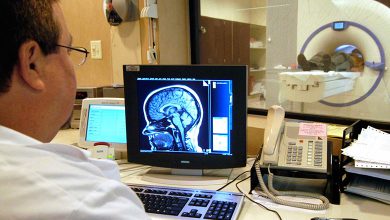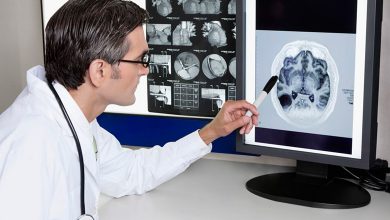Meningioma of the left frontal lobe
The content of the article
In most cases, pathological cells arise in the arachnoid space from the myelin sheaths of nerve endings or the arachnoid membrane of the brain. Depending on the growth, a node may form (if localized closer to the medulla) or lead to deformation of the skull bones. In terms of tumor frequency, meningioma ranks second, second only to gliomas, and accounts for about 25% of tumors. The disease has a clear gender characteristic - it is 2 times more common in women after 38 years of age than in men; It is rare in children - no more than 1.7% of recorded cases.
Causes
The etiology of oncological formations has only speculative data. The dominant factors of formation remain heredity and hormonal imbalances (especially in female patients). A direct connection between meningioma and breast cancer has been noted, as well as a tendency for tumors to increase in size during pregnancy. One of the proven causes is radioactive exposure (x-ray, ionizing), nitrate-containing substances, and TBI.
Symptoms
Quite often, meningioma of the frontal lobe does not have clear clinical manifestations and can be an unpleasant finding when diagnosing other diseases. Most often, the type of tumor growth is expansive - it grows in a single node, pushing apart and squeezing the surrounding soft tissue. In the case of multicentric growth, symptoms are often duplicated from other neurological abnormalities. Meningioma of the left frontal lobe has clear manifestations of signs of the disease on the opposite side of the body. Most common symptoms:
- hearing impairment;
- visual defects;
- seizures;
- speech disorders;
- loss of sensations;
- paresis and paralysis;
- flattening of emotions;
- rigidity of thinking;
- frequent seizures;
- personality change.
Diagnostics
Given the asymptomatic nature of the disease, the diagnostic process is difficult. Medical tactics are successful only when the tumor reaches a significant size. During the growth, compression is created on the surrounding soft tissue and the blood vessels of the brain are injured. MRI is considered the most informative diagnostic method with the least harm to the body .
Treatment
Based on the medical history, diagnostic data, taking into account the clinical picture, course and duration of the disease, the neurosurgeon selects an individual treatment process:
- Surgically . A fairly common method of getting rid of benign meningiomas is by opening the skull and completely or partially removing the capsule and affected fibers. With this method, it is necessary to block the blood supply before resection.
- By radiosurgery . The radiosurgical method allows you to completely remove tumor cells without much harm to surrounding tissues. The advantage is that there is no postoperative period and no anesthetic is required. During such removal, the blood vessels stick together and the blood supply to the tumor tissue is cut off. Thus, its growth stops and the danger of hemorrhage is completely stopped.
- Conservative treatment involves partial relief of symptoms as a result of taking medications from the group of glucocorticosteroids and anticonvulsants. Usually combined with one of the above methods.
The prognosis of a typical meningioma of the left frontal lobe is favorable if the tumor is detected in a timely manner. To reduce the likelihood of complications, as well as for prevention purposes, it is necessary to receive vascular treatment and undergo regular medical examinations.
Please rate the article:





